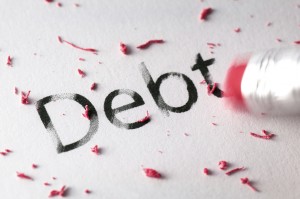What is the Difference Between Contingent, Unliquidated and Disputed Debt?
Kansas City Bankruptcy Attorneys Explain Special Types of Debts
 When you file bankruptcy, one step of the initial paperwork process is listing all your creditors and debts. On these forms, you must identify those debts that are contingent, unliquidated or disputed. These are special categories for certain debts that may be difficult to quantify in the present. A contingent debt depends on some future occurrence, which may never happen. An unliquidated debt is an obligation you owe, but for an unknown amount. Finally, a disputed debt is one that a creditor may say you owe, but you disagree. However, not all debts fall into these three categories. For example, basic claims such as credit card balances are not any of these three kinds of debt (unless you disagree with the amounts).
When you file bankruptcy, one step of the initial paperwork process is listing all your creditors and debts. On these forms, you must identify those debts that are contingent, unliquidated or disputed. These are special categories for certain debts that may be difficult to quantify in the present. A contingent debt depends on some future occurrence, which may never happen. An unliquidated debt is an obligation you owe, but for an unknown amount. Finally, a disputed debt is one that a creditor may say you owe, but you disagree. However, not all debts fall into these three categories. For example, basic claims such as credit card balances are not any of these three kinds of debt (unless you disagree with the amounts).
Bankruptcy can be an effective tool for eliminating your unmanageable debts, but the first step is filing your paperwork correctly. Listing and identifying all your debts is essential—if you do not list it, you may not be able to discharge it. Our Kansas City bankruptcy attorneys can assist you in filing this initial paperwork and throughout the bankruptcy process. We have years of experience representing Kansas and Missouri residents in both Chapter 7 bankruptcy and Chapter 13 bankruptcy cases. No matter how complicated your financial situation seems, our legal team can help.
What are Contingent, Unliquidated and Disputed Debts?
In bankruptcy, not all debts are straightforward. Sometimes it may be difficult to determine how much you owe and when you owe it. Typically, these kinds of imprecise debts are either contingent, unliquidated or disputed:
- Contingent debt. These are debts that you may owe in the future, but they depend on a certain event that has not yet happened. The most common example of a contingent debt is if you cosign someone else’s loan. You only owe money if the other person defaults. Since that may never happen, you may never actually owe the debt. Therefore, if the primary borrower is not in default when you file bankruptcy, then the loan is your contingent debt.
- Unliquidated debt. Like contingent debts, an unliquidated debt is an obligation you may owe now or in the future, but the monetary amount is currently incalculable. For example, you may be in the midst of a personal injury lawsuit. Your attorney in that matter may collect contingency fees, which means the lawyer gets a percentage of the settlement or verdict at the end of the case. You will owe your attorney’s fees, but you cannot know how much you owe until your case concludes. Therefore, personal injury attorney fees are typically unliquidated debt, if the case is still in progress.
- Disputed debt. Sometimes, a creditor may claim you owe a certain amount, but you disagree with the sum or with the claim altogether. This is a disputed debt, which can involve virtually any kind of creditor. However, you must have a legal reason why you disagree with the amount due. For example, if a credit card company charged you 30 percent interest for missed payments, but your original contract stated that this penalty would only be 15 percent, then this may be a disputed debt.
Why Should I List Debts I Disagree With or Do Not Owe Right Now?
Listing a contingent, unliquidated or disputed debt does not mean you are agreeing to or will have to pay those debts. Including a list of all claims simply means that everything you owe or might owe is considered for discharge. In many cases, this means you can eliminate your liability for these debts.
For example, while you do not technically owe a contingent debt at the time of your bankruptcy filing, you may be able to discharge your future obligation. Similarly, some unliquidated debts are also dischargeable in bankruptcy, even though the exact dollar amounts are unknown.
If you have a disputed debt, then you should take care to list the amount the creditor claims you owe, not what you believe you owe. The exact amount you owe may or may not matter since a discharge eliminates the liability – regardless of amount. This is true for both a Chapter 7 liquidation and a Chapter 13 repayment plan.
However, if you do not list a certain creditor or debt when you file for bankruptcy, then you may not receive a discharge for that debt. This means the creditor may be able to bring collection actions against you even after you receive a bankruptcy discharge. The fact is that you must list ALL debts, even ones that are not subject to discharge.
Questions About Confusing Debt? Contact Our Kansas City Bankruptcy Attorneys
The rules for filing bankruptcy can be confusing, especially if you owe or may owe many different types of debt. If you are considering bankruptcy, then contact our Kansas City bankruptcy attorneys for legal advice before you file. In a free initial consultation, we can gather information about your debts and advise you whether bankruptcy is right for you. If so, then we can assist in filing all the necessary paperwork, including generating a comprehensive list of all creditors. Whether you owe contingent, unliquidated and/or disputed debt, we will work to ensure the bankruptcy process goes smoothly.
Call (816) 561 1818 or contact us online to speak to a bankruptcy lawyer, free of charge.
 Book an
Book an Email
Email Directions
Directions







